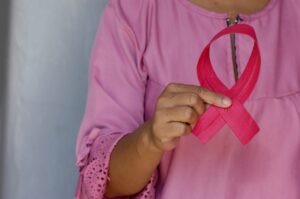 You’re probably asking yourself, “Wait—what’s so important about regular breast self-exams?” Well, it’s simple: Breast cancer can be hereditary. The most common form of breast cancer called ductal carcinoma in situ (DCIS), is a noninvasive type that grows inside the milk ducts and does not generally spread to other tissues or organs. However, there is a risk for DCIS to become invasive if it isn’t detected early on.
You’re probably asking yourself, “Wait—what’s so important about regular breast self-exams?” Well, it’s simple: Breast cancer can be hereditary. The most common form of breast cancer called ductal carcinoma in situ (DCIS), is a noninvasive type that grows inside the milk ducts and does not generally spread to other tissues or organs. However, there is a risk for DCIS to become invasive if it isn’t detected early on.
While the majority of breast cancers are not hereditary, about 5-10% are caused by genetic mutations passed down from a family member. If you have a family history of breast cancer, it is especially important to keep track of your health and undergo annual mammography screenings starting at age 40. Even if you don’t know much about your ancestors’ medical histories, this kind of screening is still beneficial as it can catch cancers earlier when they are more treatable and curable.
Understanding the significance of a family history of breast cancer
It’s estimated that approximately 10–15 percent of women with breast cancer have a family history of it, which means there’s at least one first-degree relative—a parent, sibling, or child—who also had the disease. While this is a risk factor for developing breast cancer, it doesn’t mean you’re guaranteed to develop the disease.
BRCA mutations can increase risk by 2–12 times. However, they’re only present in about 5 percent of those who have a family history of breast cancer. In those cases, other factors like the number of first-degree relatives and age are important to consider. Women who have 4 or more first-degree relatives with breast cancer before their 70th birthday have a much higher risk than those with fewer relatives affected in their lifetime. Also, about half of all women diagnosed with breast cancer will be younger than 60 years old when they get it; if you fit into this category and your family has a history of the disease, then knowing more about your genetic heritage is important to understand your personal risk level.
Family history is only one factor. Others include age (older patients tend to be diagnosed later) and reproductive history (women who never have children are exposed longer to more circulating estrogens that can promote tumor growth over time).
What Can I Do to Reduce My Risk?
In the meantime, you can reduce your risk by following these steps. The National Cancer Institute recommends that women at average risk for breast cancer should have a clinical breast exam (CBE) every three years starting at age twenty. Women who are at high-risk should receive an MRI scan annually beginning at age 25 instead. If you develop a lump or change in your breasts, see your doctor right away. In addition to these methods, here are ways that could also help reduce your risk of developing breast cancer in the future:
Live a healthy lifestyle
There’s no getting around it: living with a family history of breast cancer is hard. If a close family member has or had breast cancer, you’re at greater risk of developing it yourself, but that doesn’t mean you have to live in fear. Studies show that lifestyle changes can reduce your chances of getting breast cancer by as much as 30 percent. You’ll rest easier knowing that you’re taking steps towards prevention.
Think about getting genetic counseling and testing
Genetic counselors can help you assess your risk through a more comprehensive look at your family’s medical history, and if you do have an increased chance of developing it, there are several different options for dealing with that challenge.
If you’re concerned about either yourself or a loved one having breast cancer in the future, you should get in touch with a genetic counselor as soon as possible. The process of getting tested doesn’t necessarily have to be especially frightening or overwhelming; as long as you know some basics about what to expect, it can be a straightforward and easy step to take toward a better understanding of what may happen in the future.
Exercise, diet, and limiting alcohol
By combining these three strategies—diet, exercise, and limiting alcohol consumption, you’ll lower your risk even further while also keeping yourself feeling healthy and strong.
The most effective way to fight breast cancer is by limiting exposure to known cancer-causing agents: alcohol, tobacco products, unhealthy foods, overexposure to radiation (including from electronic devices), and exposure to high levels of air pollution. Doing so will keep your hormones in balance and prevent additional cell damage that could increase the chances of developing a metastatic tumor or even a new primary tumor later on.
In addition to avoiding known carcinogens, it’s important to include a variety of vegetables and fruits high in antioxidants into your diet. Staying active by exercising regularly is another key benefit.. Exercise has been linked to improvements in both physical health as well as mental health, which helps you deal with stress.
You’re not alone. A family history of breast cancer affects about 15% of women – the good news is that you can take steps to lower your risk. So, learn more and talk to your doctor. There is no better time than now to be proactive in your protection against breast cancer.
